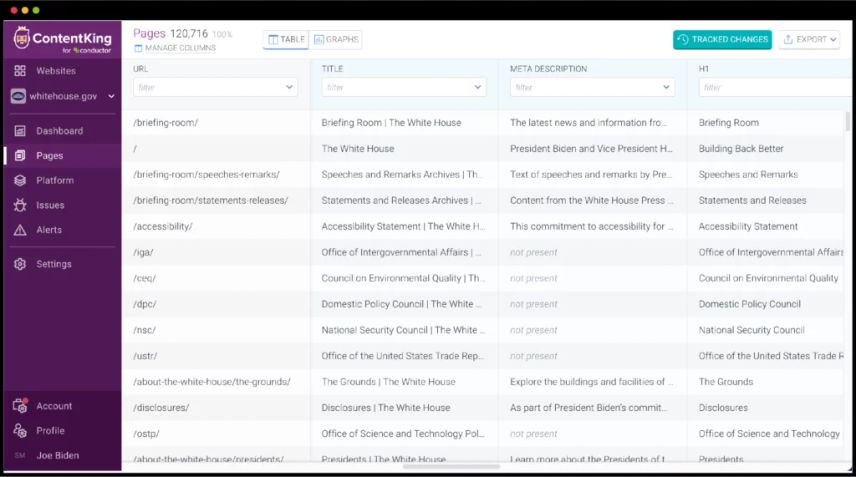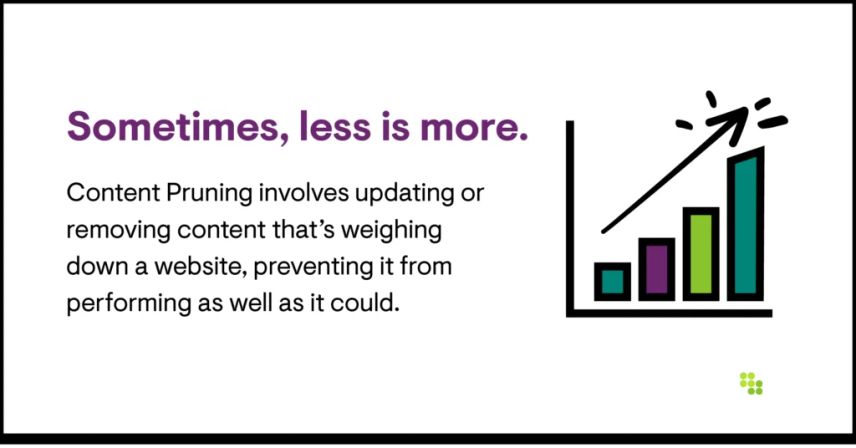How to Run an Effective Content Audit
A content audit is the process of organizing and reviewing all of your website’s content to see how it performs organically. An audit will show you what works well in your current content strategy and what can be improved. It's an essential step in your content creation process that should be completed at least twice a year, if not quarterly.
True or false? For a while, you’ve mainly been concerned with creating new content for your site. You’re producing new pieces to answer your audience’s questions and drive relevant organic traffic. That’s a great place to start.
But what happens after you’ve done nothing but create net new content for a quarter? Or six months? Or a full year?
Your site piles up with content, the great pieces that are consistently ranking, the weaker and outdated pieces that may not rank at all, and those pieces in between that just need some care and attention to double its traffic. At this point, more content isn’t necessarily better for your site. It’s just more.
But before spending time and resources taking hedge trimmers to your blog or updating old pieces at random, you need to fully understand the state of your content, how it’s performing, whether it needs updating, and maybe even whether it sparks joy . To do any of this, you need to complete a content audit, and continue to perform them on a regular cadence.
Some organizations only perform an audit once every few years, but this is short-sighted at best, and potentially disastrous at worst. I understand, it’s a pain to manually pull all of that information, but in order to get the most out of your audits, and keep your content quality high, you need to perform them more regularly. By running a content audit too infrequently, you risk losing valuable traffic and authority within your space. Luckily, there are a number of efficient ways to pull data for your audit and future-proof this all-too-important process.
What is an SEO content audit?
A content audit is the process of organizing and reviewing all of your website’s content to understand its organic performance. Essentially, it’s a snapshot of your content’s performance over time, offering insights on what content is performing well, where there are opportunities to improve content with rewrites or by merging with other relevant articles, and what you can phase out or redirect entirely.
Why is a content audit important?
A content audit offers you a holistic view of how your pieces of content perform, providing key insights to inform and adjust your overall marketing strategy. Metrics are central to your goals, and incorporating them in your content audit gives insight into what your time and resources go towards and the return on those investments.
Understanding what pieces are successful will also help inform why they are performing well, giving insight into your target audience's questions and the most impactful way to answer them. But a content audit benefits more aspects of your business than just your content and technical SEO practices. A content audit can show you:
- Gaps in your conversion funnel
- Opportunities to boost your existing content with new or supporting pieces
- Instances where keyword cannibalization is harming your traffic
- Opportunities to improve your overall site’s content quality
A content audit can also help other aspects of your business by allowing you to recalibrate your current marketing budget. If you’re spending big on paid media, a content audit could show opportunities for growth through organic traffic. A content audit also helps in uncovering gaps in your conversion funnel. For example, you may have content that is very strong for educating people about a certain topic but not much content for the customers who are looking to make a purchase.
A content audit shows opportunities to boost your existing content with new or supporting pieces and places you can add by subtracting. For example, incidents of keyword cannibalization. Imagine you are creating content around running shoes, and you have two articles that happen to rank for the query: ‘The ten best discount running shoes.’’ These two articles will compete against each other, despite being on the same site. This is called keyword cannibalizationKeyword Cannibalization
Keyword cannibalization, also known as URL cannibalization or keyword cannibalizing, means that two subpages of a domain rank on the same keyword(s). This SEO mistake has a negative impact on ranking success but is easy to fix with the right keyword strategy.
Learn more and can actually harm both pieces of content. Keyword cannibalization represents an opportunity to gain relevant traffic by consolidating or removing a piece entirely.
Finally, a content audit reveals the overall quality of the content on your site. This is critical from a user and an SEO perspective. If the content on your website is poor, then your audience won’t find it helpful, and Google may not even surface it. Google prioritizes helpful content , their goal is to provide users with the most relevant results based on their search. Taking the time to understand the quality of your content goes a long way in helping you optimize your site’s content, as well as how you approach content creation. Understanding what content of yours works and why can also help you create more effective content briefs.
Thanks to an SEO content audit, you know exactly where you stand; the good, the bad, and everything in between.
When and how often should I perform a content audit?
As a general rule of thumb, we recommend completing an audit roughly once a quarter or twice a year at the very least, which allows you to build a backlog of content to audit while not waiting too long to make critical changes.
Given how important I just explained content audits to be, you could be forgiven for immediately getting the process started in your mind. But just because it’s important doesn’t mean you must complete it immediately. Every business is different, and depending on where you are in your content marketing strategy, you could better use your resources elsewhere.
If you aren’t sure it’s the right time to run a content audit for your site, consider the last time you completed an audit and how much content you’ve created since. Also, consider the age of your site; if your site is still new, the chances are that you don’t have enough of a backlog of content to see results from an audit. If you haven’t conducted an audit in more than six months and have a backlog of content, it’s vital to prioritize one.
How to perform a content audit in 5 easy steps
Now, it’s time to get into the weeds of your content with the help of our comprehensive content audit guide.
1. Define success
This step is your north star. What do you hope to learn from a content audit, and what information do you want to come away with? Do you want to boost your rankingsRankings
Rankings in SEO refers to a website’s position in the search engine results page.
Learn more on the SERP? Increase audience engagement? Create a better user experienceUser Experience
User experience (or UX for short) is a term used to describe the experience a user has with a product.
Learn more? Or maybe you want to maximize conversions. Let’s face it, you probably want to accomplish more than one of these goals, but keep in mind that the narrower your focus, the easier it will be to plan for success and drive toward it.
Some examples of metrics you can use to define success include:
- Organic traffic
- Rankings
- Number of backlinks
- Social engagement
- Conversion rate
When choosing which metrics to target, consider those that align with your overall content strategy, how you as a marketing team define success. Which metrics will help prove the value of your investment in SEO and get buy-in across the organization? Those are the ones to prioritize.
2. Take inventory of your existing content
I can hear you stressing over this step, but take a deep breath. Yes, this will be a reasonably tedious process, especially if you have a large site. Still, it’s essential for a comprehensive understanding of all of your published content. And the good news is that there are a few ways to speed up this step that we’ll cover in more depth.
First, use a Google Sheets or Excel spreadsheet to organize key data points. You can create your own spreadsheet, but in the interest of streamlining this process as much as possible, we made a content audit template to get you started. We included all of the basic categories you’ll need to understand your content’s performance. Download our template so you can spend less time planning for your audit and more time performing and learning from it.
You can now start exporting your content into your audit spreadsheet. Critical pieces of information to include are:
- URLs
- Author(s)
- Publication date
- Pro tip: You can configure ContentKing to to send alerts if content has been updated recently , to ensure you’re always up to date.
- Update date
- Target keyword(s)
As tedious as this process seems, it’s the pillar supporting your entire content audit, and, best of all, there are ways to streamline it beyond using a content audit template. For example, ContentKing can help you automatically pull information like author and date of publication or update with their Custom Element Extraction feature . You can monitor and audit your entire site in real-time for an ever up-to-date content audit with ContentKing, or you can manually piece an audit together using tools like Google Search ConsoleGoogle Search Console
The Google Search Console is a free web analysis tool offered by Google.
Learn more or Screaming Frog.
3. Categorize your content
Once you have all your URLs in one place, you’ll need to make the information more digestible. After all, the goal of a content audit is to organize and understand your content, so a string of seemingly endless URLs is overwhelming at best and will only make the rest of the audit more difficult. Stay organized and start categorizing content, so it’s easier to analyze and identify insights.
Consider the surface-level information of your content to understand which categories to include.
- Content format
- Content type
- Funnel stage
- Word count
You’ll notice our template also includes spaces for the metadata of each piece of content. This inclusion makes updating these data points easier and offers broader context on a piece beyond just the URL. While not a necessity, we suggest you include the following properties to make your audit as thorough as possible.
- Title tag
- Meta description
- H1
- H2s
- Pro tip: ContentKing includes the ability to monitor and pull the above information as a default feature of the platform.

You now have all of the initial information about the content on your website, so you need to tie key metrics and data points to them to understand how your content has been performing. Pull in the data points that define success for your content from step one, and include them in your audit.
- Organic traffic
- Conversions
- SERP rank
- Number of backlinks
- Social shares and engagements
- Any other key metric your team agreed on
Again, this part of the process can be fairly time-consuming, but there are ways to speed up and even automate organizing your audit. Specifically, you can save time with your Google or Adobe Analytics platform to quickly pull your important metrics. You can also easily integrate these analytics platforms into an SEO platform, like ContentKing, to have everything in one convenient location.
- Pro tip: You can automatically pull this data for the last 90 days into your audit if your site is integrated with Google Analytics and Google Search Console. Screaming Frog also offers similar, albeit manual, functionality.
4. Analyze your findings
At this point, you should have a well-organized and extensive SEO content audit, so it’s time to figure out what this data is telling you. Think of this almost as if you’re assigning a score to your content based on things like traffic and engagement or your specific team’s goals and KPIs. Be critical as you analyze your content performance, staying vigilant for any opportunities to boost your site’s presence and authority by pruning poor or outdated content.

Specifically, be on the lookout for the following:
- Underperforming content: Pieces currently not hitting the marks you set while preparing for this audit. Underperforming pieces are opportunities to review, rewrite, and optimize the content to drive more relevant organic traffic. For these pieces, it also pays to review the Google SERP, specifically page one, to understand what content is currently ranking well and how far behind your content is. This will provide important insight into what your content is up against and how realistic it is for you to create something superior to the highest-ranking pieces.
- Outdated content: Times change, and so do the things you write about. Not all of your content can be evergreen, so keep an eye out for content that no longer makes sense or can in some way be updated to include more recent information. This will also include pieces written for a specific year, such as ‘Top 10 products of 2016.’
- Thin/Irrelevant content: Thin content refers to content that doesn’t offer much helpful context for a topic or hasn’t been fully fleshed out. Depending on the circumstances, you can redirect some of these pieces, but others are opportunities to prune, boosting your overall site health. That said, some thin content could hold helpful or relevant nuggets of information that you can use to improve other content, so be wary of deleting too much content. Consider storing these pieces of content in a Google Drive folder so that you can access and repurpose relevant information as needed.
We recommend further categorizing your content based on these groups to understand your next steps and priorities quickly.
5. Take action
You should have your content in these quality-based categories we mentioned in the last step, so your team can start taking action based on your findings. Your content that’s working is the easiest one to deal with because you can just leave those pieces alone.
For the most part, your thin and irrelevant content can be pruned or redirected to a related piece of content on your site. Back to the example about having two competing discount running shoe articles, you can choose to redirect from one piece to the stronger one or delete one entirely.
Next up is your outdated and underperforming content, and this is the trickiest category to handle because your next steps are up to you. Deleting this content simply for being old or poor is short-sighted, but leaving these pieces alone is not an option either. So, you’ll need to rewrite and optimize much of this content, or at the very least, use it as inspiration to create net new content.
To be clear, this old or underperforming content may still be answering a question that is relevant and helpful to your audience but just not be optimized to rank in the SERP. Look for opportunities to merge, rewrite, or improve these pages' content and technical SEO aspects. And once you identify these opportunities, start planning how you’ll tackle them and which projects will drive the most ROI. To help you prioritize and keep yourself organized, we recommend organizing everything into a centralized content calendar .
Finally, your SEO content audit most likely revealed gaps in your current content strategy. Content gaps are chances for you to answer an important question your audience has or provide relevant information on a topic related to your brand that you haven’t already covered. Content gaps are opportunities to build trust with your target audience by alleviating a pain point or answering a question of theirs. If your audience trusts that you are an authority in your industry, they are more likely to visit your site in the future when they are ready to make a purchase or otherwise convert.
For example, maybe you sell coffee makers but don’t have an article about how to clean them. You could drive significant short-term organic traffic by answering this question for your customers, as well as long-term traffic by reinforcing your authority in the space.
While your audit may have left some gaps, you’ll need to perform a content gap analysis to get a complete picture of your missing content.
At this point, you understand where your content stands and how to tackle each piece individually. But you’ll also need to ask yourself some important questions to understand how your audit affects your overall content strategy. Some things you should consider based on your audit are:
- Whether you need to adjust your buyer personas or content calendar.
- Whether there is an opportunity to bring more authority to your content.
- Whether you’re targeting the right audience or queries.
- Whether your ideation or publication process needs updating.
- Whether there are chances to beef up your content briefs.
How can I speed up the process of performing a content audit?
While central to your content strategy and site health, it's true that this process can be very manual and time-consuming. Luckily, you can speed up your content auditing process and make it more repeatable for next time, beyond the analytics and inventory tools we mentioned earlier, most notably:
Use a content audit template
One surefire way to make any process more repeatable is to employ a template. While you can work with your team to create a template, you can save time and download a copy of our content audit template, including all the basic categories your audit will need.
Is there a way to automate a content audit?
Absolutely. You can automate your content audit to remove as much manual intervention from the process as possible using tools and SEO platforms. Platforms that offer real-time content monitoring or integration with analytics platforms help to automate the data collection of the audit process.
In addition, you can seamlessly plan and share next steps with your team through Conductor’s integration with task management tools like Asana, Jira, and Trello. With Conductor and ContentKing, the auditing never stops; it just needs less manual intervention.
Let your audit begin
Ultimately, success is a moving target. Content is essential to driving organic traffic to your website, but you need to adjust your strategy as times change, content loses relevancy, and topics get more competitive. Your site is never finished, and needs continuous attention to make sure it’s at its best. You should always be in some kind of improvement or maintenance mode, in order to drive the most impact with your content. You need to understand what you’re up against, what’s working in your current strategy, and what’s lacking or outdated. You need to add an SEO content audit to your regular housekeeping processes.
If you haven’t already, start auditing now and download our comprehensive Content Audit Template to streamline and future-proof your content audit process.







